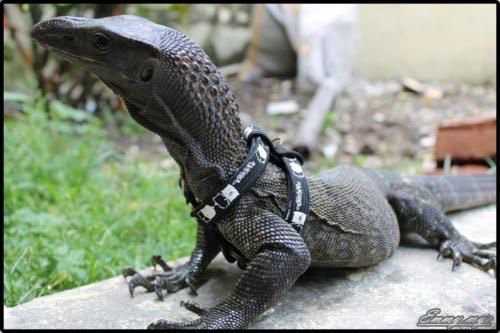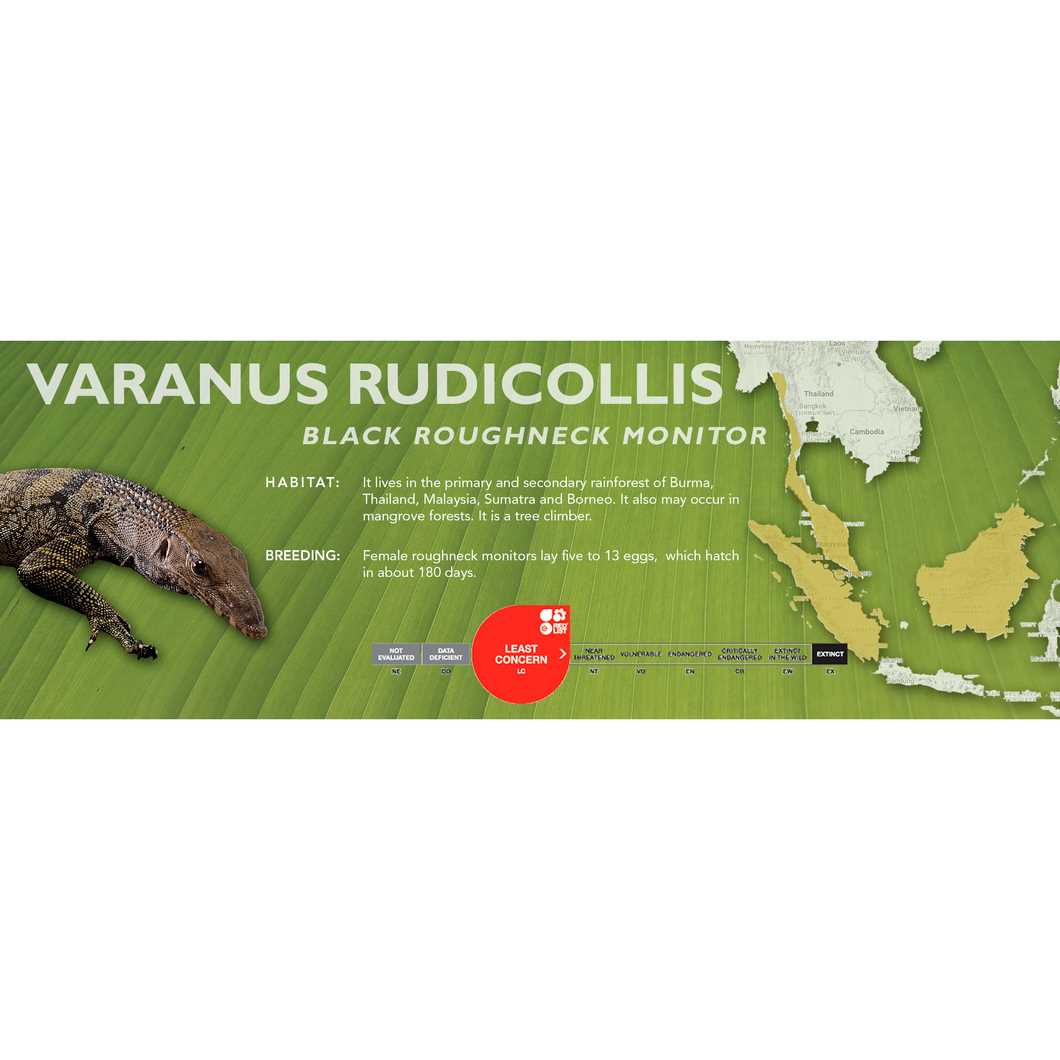
Roughneck Monitor: A Fascinating Reptile
The Roughneck Monitor is a captivating reptile that belongs to the monitor lizard family. Known for its distinct physical characteristics and aggressive nature, this reptile is a popular choice among reptile enthusiasts.
As a carnivore, the Roughneck Monitor has specific dietary requirements. Its diet primarily consists of small mammals, birds, eggs, and insects. With its sharp teeth and powerful jaws, this reptile is a skilled hunter and can easily capture its prey.
One of the striking features of the Roughneck Monitor is its rough textured skin, which gives it the name “roughneck.” The skin is usually dark in color, providing the reptile with excellent camouflage in its natural environment. Additionally, the monitor has a long, muscular tail, which it uses for balance and swimming. This makes it a versatile reptile that is equally comfortable in both terrestrial and aquatic habitats.
Due to its aggressive nature and large size, the Roughneck Monitor requires an experienced handler. While it can be tamed to some extent, it is essential to approach this reptile with caution. Regular handling and socialization from an early age can help establish a bond of trust with the monitor.
Overview of the Roughneck Monitor
Habitat and Natural Range of the Roughneck Monitor
The roughneck monitor is a species that prefers to inhabit the lowland forest areas. It can be found near rivers, streams, and swamps, as it is a semi-aquatic reptile. This means that it spends a significant amount of time in or around water. It builds its shelter using burrows in riverbanks or tree cavities.
The natural range of the roughneck monitor includes countries such as Thailand, Malaysia, Borneo, and Sumatra. These regions offer a suitable habitat for the reptile, with a combination of lush vegetation, water sources, and an abundance of prey.
Physical Characteristics of the Roughneck Monitor

The roughneck monitor is a large lizard, reaching a length of up to 3-4 feet. It has a muscular build with a long tail that helps it maintain balance both in and out of the water. The body is covered in rough scales, giving it the distinct roughneck appearance.
One of the most striking physical features of the roughneck monitor is its coloration. It has a dark brown to black body with yellow or cream-colored stripes or bands across its back. These markings vary in intensity and can be used for camouflage in their natural habitat.
The roughneck monitor also possesses sharp claws, powerful jaws, and a long, agile tongue. These adaptations help it catch and consume its prey, which mainly consists of small reptiles, rodents, birds, and amphibians.
Conservation Status and Importance of the Roughneck Monitor
The roughneck monitor is currently classified as a species of least concern, according to the International Union for Conservation of Nature (IUCN). This is due to its wide distribution and adaptability to different habitats. However, it still faces various threats, such as habitat loss and fragmentation.
Habitat and Natural Range of Roughneck Monitor
The Roughneck Monitor is a fascinating reptile that is native to Southeast Asia. It can be found in countries such as Indonesia, Malaysia, and Thailand. This aggressive and territorial lizard is known for its distinctive rough scales and powerful tail.
The roughneck monitor is a carnivore, and its diet mainly consists of small mammals, birds, and reptiles. It is an excellent swimmer and is often found near rivers, streams, and other bodies of water. It is also known to be a skilled climber and can often be spotted in trees.
The roughneck monitor requires a spacious and well-maintained terrarium to thrive. The terrarium should have a water source for the monitor to swim in, as well as plenty of hiding spots and climbing opportunities. The temperature and humidity levels should be carefully monitored to ensure the monitor’s health and well-being.
| Habitat | Natural Range |
|---|---|
| Forests | Indonesia |
| Swamps | Malaysia |
| Grasslands | Thailand |
These terrarium conditions should mimic the roughneck monitor’s natural habitat, which typically includes forests, swamps, and grasslands. Providing a suitable habitat is crucial for the monitor’s overall well-being and longevity.
Physical Characteristics of the Roughneck Monitor
The roughneck monitor is a medium-sized lizard, typically reaching lengths of 2 to 3 feet. It has a long, slender body with a muscular build, allowing it to navigate its environment with ease. One of its most striking features is its rough-textured skin, which is covered in small, pointed scales that resemble armor plating. These scales provide a layer of protection against potential predators and are usually colored in shades of dark brown or black, helping the roughneck monitor to blend in with its surroundings.
The roughneck monitor has a unique head shape, characterized by a large, triangular skull. It has sharp teeth and strong jaws, enabling it to capture and consume its prey. This monitor lizard is an aquatic reptile, spending a significant amount of time in the water. Its nostrils are positioned on the top of its snout, allowing it to breathe while partially submerged.
Aggressive Behavior and Territorial Nature
The roughneck monitor is known for its aggressive behavior, especially when it feels threatened or cornered. When approached, it will often raise its body off the ground and hiss, displaying its formidable teeth as a warning. If provoked further, it may bite or even lash out with its strong tail, capable of delivering powerful strikes.
In the wild, roughneck monitors are territorial creatures. They establish and defend their territories, often engaging in fierce battles with other individuals of the same species. These territorial disputes can involve aggressive displays, such as head bobbing and tail whipping.
To house a roughneck monitor in captivity, a large and secure terrarium is necessary. The enclosure should provide ample space for the lizard to move around, climb, and swim. Additionally, a water source, such as a large pool or pond, is essential for the monitor’s well-being, as it requires regular access to water for hydration and to regulate its body temperature.
Overall, the roughneck monitor is an intriguing reptile with its striking physical characteristics and aggressive behavior. Its unique adaptations make it a captivating and rewarding species for reptile enthusiasts to observe and study.
Roughneck Monitor: A Fascinating Carnivorous Lizard
The roughneck monitor is a intriguing reptile that belongs to the monitor lizard family. Known for its aggressive behavior and striking appearance, the roughneck monitor is a popular choice among reptile enthusiasts.
One of the distinctive features of the roughneck monitor is its tail, which can be longer than its body. This long tail helps the lizard maintain balance while climbing trees and navigating its surroundings. In addition to its tail, the roughneck monitor has sharp claws and strong jaws that make it an efficient predator.
The roughneck monitor is a carnivore, meaning it primarily feeds on meat. Its diet consists of small animals such as birds, rodents, and insects. This lizard is known for its voracious appetite and can consume prey that is relatively large in size compared to its own body.
Keeping a roughneck monitor as a pet requires a carefully designed terrarium with ample space for the lizard to roam and climb. The temperature and humidity conditions within the terrarium should closely mimic the lizard’s natural habitat.
Behavior and Interaction
The roughneck monitor is known for its intelligence and curiosity, which makes it an interesting reptile to observe and interact with. With time and patience, owners can build a strong bond with their pet roughneck monitor.
Conservation Status
Conservation Status and Importance of Roughneck Monitor
The Roughneck Monitor plays an important role in its ecosystem as a top predator. As a carnivore, it feeds on a wide variety of prey, including small mammals, birds, reptiles, and insects. This makes it a crucial part of the food chain in its natural habitat.
Unfortunately, the Roughneck Monitor is facing conservation concerns due to habitat loss and illegal pet trade. Their natural range has been significantly reduced due to deforestation and the conversion of their habitat into agricultural land. Additionally, they are often captured and sold as pets, leading to a decline in their population in the wild.
Conservation efforts are being made to protect the Roughneck Monitor and its habitat. Efforts include establishing protected areas and raising awareness about the importance of conservation. The Roughneck Monitor is listed as a vulnerable species on the International Union for Conservation of Nature (IUCN) Red List, highlighting the need for conservation initiatives.

I’m Lena Adams—a product of an unconventional upbringing in the African wilderness. My father, a daring explorer of African wildlife, sparked my fascination with reptiles, a passion that intertwined with the tragic loss of my mother during an expedition, leaving an indelible mark on my life. Driven to understand the creatures that captivated my parents, I embarked on my journey, sharing insights about reptiles, frogs, and lizards on my website. Through my explorations and conservation efforts, I honour my family’s legacy while seeking connections—to the creatures, nature, and the mother whose presence I yearn to understand.
